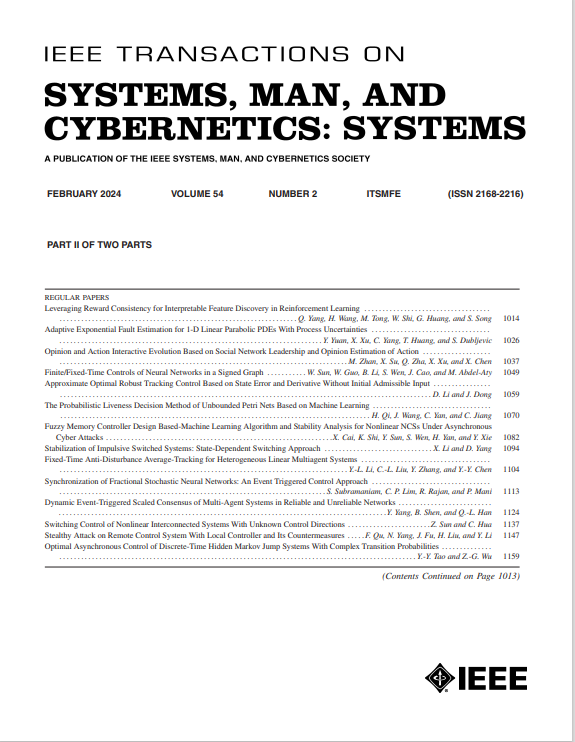New Results on Interval Type-3 Fuzzy Control for Nonlinear Time-Delay Systems Using Convex Relaxation Technique
IF 8.6
1区 计算机科学
Q1 AUTOMATION & CONTROL SYSTEMS
IEEE Transactions on Systems Man Cybernetics-Systems
Pub Date : 2025-03-06
DOI:10.1109/TSMC.2025.3543170
引用次数: 0
Abstract
In this article, the interval type-3 fuzzy-based state feedback control is proposed for the stabilization problem of interval type-3 fuzzy systems (IT3FSs) subject to time-varying delay. Specifically, to improve the model accuracy and control capabilities, we proposed a nonparallel distributed compensation-based controller approach, be precise, the system and controller adopts the distinct membership functions. Moreover, the stability analysis of IT3FSs in the state space form is studied newly in this article. Besides the primary membership function that exists for interval type-2 fuzzy systems (IT2FSs), the IT3FSs possess the secondary membership function to handle the overall uncertainty which enacts the superiority of the proposed work. Notably, the adequate stability criteria are derived in the form of linear matrix inequality (LMI) using the Lyapunov stability theorem. Additionally, the convex relaxation technique is used to strengthen the design flexibility and achieve the faster convergence rate, which converts an optimization problem with a vector variable to a convex program with a matrix variable, via a lifting technique. A noteworthy aspect is that the application of the convex relaxation technique in the context of IT3FSs is proposed for the first time in literature. Finally, the comparative results between IT2FSs and IT3FSs are shown via two illustrative examples, including the inverted-pendulum model, to underscore the efficacy and practical implementations of the developed control methodology.非线性时滞系统区间3型模糊控制的凸松弛新结果
针对区间3型模糊系统的时变时滞镇定问题,提出了基于区间3型模糊的状态反馈控制方法。具体来说,为了提高模型的精度和控制能力,我们提出了一种基于非并行分布式补偿的控制器方法,该方法精确,系统和控制器采用不同的隶属函数。此外,本文还对it3fs在状态空间形式下的稳定性分析进行了新的研究。区间2型模糊系统除了具有一级隶属函数外,还具有处理整体不确定性的二级隶属函数,从而体现了本文方法的优越性。值得注意的是,利用李雅普诺夫稳定性定理,以线性矩阵不等式(LMI)的形式导出了充分的稳定性判据。此外,采用凸松弛技术,通过提升技术将矢量变量优化问题转化为矩阵变量的凸规划,增强了设计的灵活性,实现了更快的收敛速度。值得注意的是,文献中首次提出了凸松弛技术在it3fs背景下的应用。最后,通过包括倒摆模型在内的两个示例,展示了it2fs和it3fs之间的比较结果,以强调所开发的控制方法的有效性和实际实施。
本文章由计算机程序翻译,如有差异,请以英文原文为准。
求助全文
约1分钟内获得全文
求助全文
来源期刊

IEEE Transactions on Systems Man Cybernetics-Systems
AUTOMATION & CONTROL SYSTEMS-COMPUTER SCIENCE, CYBERNETICS
CiteScore
18.50
自引率
11.50%
发文量
812
审稿时长
6 months
期刊介绍:
The IEEE Transactions on Systems, Man, and Cybernetics: Systems encompasses the fields of systems engineering, covering issue formulation, analysis, and modeling throughout the systems engineering lifecycle phases. It addresses decision-making, issue interpretation, systems management, processes, and various methods such as optimization, modeling, and simulation in the development and deployment of large systems.
 求助内容:
求助内容: 应助结果提醒方式:
应助结果提醒方式:


